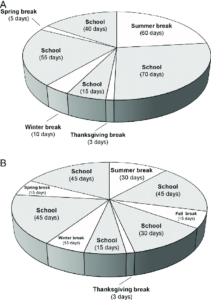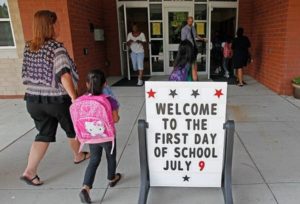Grace DiBuono-Krafick is a junior at Wilton High School. As a Staff Writer for The Forum, her favorite topics to write about are current events, local news, and sports. Besides being an avid writer, she plays softball and volleyball. She also participates in many other clubs at Wilton High School, including Amnesty International and Key Club. Outside of school, she loves spending time outdoors and with friends and family.
Year-round school sparks debate
A new educational phenomenon moves to replace traditional school calendars
November 30, 2022
Don’t worry; it’s not what you think it is.
Recently, year-round calendars have become more popular among American schools. Year-round schooling swaps a traditional summer vacation for smaller breaks interspersed throughout the course of the school year.
A major misconception about year-round schooling is that students are in school for more days than students whose schools follow a traditional calendar. Most year-round schools still have around 180 days of school, but the school calendar is formulated differently.

For example, a school following a year-round calendar may have six weeks of learning followed by a two-week break. The breaks throughout the year add up to what would have been a traditional summer vacation for a school that follows the traditional Labor Day to Memorial Day calendar.
According to a brief of year-round schools from the Congressional Research Service, there were 3,700 year-round public schools in the United States during the 2011-2012 school year (the most recent year that data is available). This represents 4.1% of all public schools in the nation. Considering an upward trend in the number of year-round public schools in the United States (a 20.6% increase between 2006-2011), this percentage is thought to have increased since 2011.
In November 2021, former New York City mayor Bill de Blasio recently proposed a free, public year-round schooling plan that would provide relief for working and lower class families. The Richmond, Virginia school board is also currently revisiting the possibility of implementing year-round school.
Arguments for and against year-round schools have circulated since the development of year-round school schedules. Recent studies can help shed light on the benefits and drawbacks that year-round education has on students, teachers, and families.
The pros
Year-round education presents educational and emotional benefits that traditional school calendars are unable to offer.
“Students in year-round programs rate slightly higher in retaining learned material,” a 2004 study from Duke University by Harris Cooper, a national expert on year-round schooling, mentioned. “The difference is even larger for students who are struggling in school or come from low-wealth families.”
The trend of year-round schooling helping low-income students is a common thread throughout recent studies.
“Economically disadvantaged students improved at a faster rate than their peers at traditional calendar schools,” according to a comprehensive study of Virginia’s year-round schools. “A likely contributing factor to this improvement for certain student groups is the additional instructional time provided to year-round school students during intersessions, as well as reduced summer learning loss.”
Additionally, year-round school is often seen as a solution to family hardships.
“In an era when schools are often hubs for health care and other services, year-round schools have the added perk of allowing access to such services to continue throughout the calendar year,” argued Jaclyn Zubrzycki in an article from EducationWeek.
With burnout and the mental health struggles of those involved in education becoming important topics, year-round school is often seen as a way to counteract these issues.
“The use of a balanced calendar could help to prevent staff burnout by providing more frequent breaks for staff,” according to the brief of year-round school by the Congressional Research Service.
Students often agree with this perspective.
“The students will get more sleep and will have more breaks [with year-round schooling]. They will be healthier and will learn more,” said Ben, an American high school student in a student survey.
Some students see year-round school as an opportunity to develop better routines.
“It is also harder for students to get back in the rhythm after a really long break. The longest break should be three weeks,” said Christian, in support of year-round education.
Overall, year-round schooling seems like an effective solution to certain economic and emotional disparities within education; however, certain studies about its effects are inconclusive. Others push back against year-round schooling on the basis of family scheduling and the quality of children’s lives.
The cons
The intentions of schools in implementing a year-round calendar don’t often pan out as expected.
According to a study conducted by the University of Lynchburg, students who have attended year-round schools actually underperform compared to traditional school students when they are integrated into traditional schools.
“The [year-round education] students did perform academically better than traditional students, but this gain slowly decreased when the students were integrated back into traditional middle school,” said an analysis of the study conducted by University of Rhode Island students Ana Nimaji and Kateri Gomes.
This startling figure suggests that while students may thrive in year-round school environments, their inevitable combination with students who have attended traditional schools may lead to their falling behind, whether this combination is in higher education or on the job front. Financial insecurity in areas with year-round schools is a possible explanation for this disparity.
Some point to economic issues as reasons why year-round school calendars should not be encouraged.
“Operating on a year-round schedule may require paying more staff … on 12-month contracts instead of 9-month contracts, thereby increasing operational costs,” said the brief from the Congressional Research Service.
While year-round schooling is often implemented as a financial solution, having to increase teacher salaries on a year-round schedule has the opposite effect. Families also often oppose year-round schooling.

“According to one study, [year-round schooling] can be so unpopular that families are willing to pay more to live in an area with a traditional calendar and this decision has a negative result on property values,” said the University of Rhode Island. “One study found that properties in year-round school areas go down by 1-2 percent in value.”
Statistically, it seems that traditional schooling still remains the preferred type of education. Other than that, year-round education may lead to scheduling issues for families.
“Families may find it difficult to have their children on different schedules if year-round schooling is not offered districtwide,” as stated by the Congressional Research Service.
Students, the people who year-round schooling affects the most, also often oppose the idea of going to school year-round.
“I think students would focus better knowing they only need to finish nine months of school and then they can have a long break to look forward to,” said Gabriel.
Other students cite the effectiveness of the traditional calendar as a reason why year-round education should be discouraged.
“I support the traditional school calendar because it has worked for centuries,” noted Kevin.
With the traditional school calendar proving its effectiveness in some schools, year-round school is often seen as an unnecessary, added complexity.
However, a healthy balance of benefits and drawbacks surrounding year-round school lead it to be an intriguing area of interest for many. In a rapidly shifting society with new research constantly emerging, year-round school is a point of study and experimentation for many school districts, especially those with low-income families. The debate about the effectiveness of traditional school versus year-round school will continue.
The final word
The development of the traditional school calendar was historically based on the need for students to work on family farms in the summer, but this is no longer an obligation for most American students. As America becomes more modernized and shifts further away from an agrarian society, school calendars have felt the pressure to evolve. The development of the year-round school calendar represents a departure from old societal constructs and the inauguration of new ideas meant to aid in an increasingly modernized and urbanized society. As science, research about education, and the development of society push forward, so will educational reforms.

